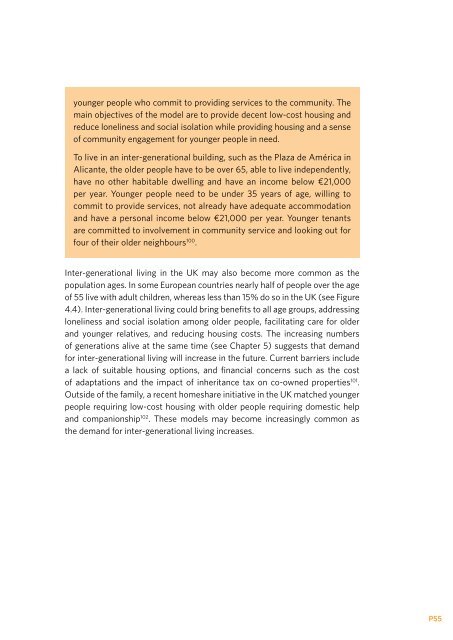Future of an Ageing Population
gs-16-10-future-of-an-ageing-population
gs-16-10-future-of-an-ageing-population
You also want an ePaper? Increase the reach of your titles
YUMPU automatically turns print PDFs into web optimized ePapers that Google loves.
younger people who commit to providing services to the community. The<br />
main objectives <strong>of</strong> the model are to provide decent low-cost housing <strong>an</strong>d<br />
reduce loneliness <strong>an</strong>d social isolation while providing housing <strong>an</strong>d a sense<br />
<strong>of</strong> community engagement for younger people in need.<br />
To live in <strong>an</strong> inter-generational building, such as the Plaza de América in<br />
Alic<strong>an</strong>te, the older people have to be over 65, able to live independently,<br />
have no other habitable dwelling <strong>an</strong>d have <strong>an</strong> income below ¤21,000<br />
per year. Younger people need to be under 35 years <strong>of</strong> age, willing to<br />
commit to provide services, not already have adequate accommodation<br />
<strong>an</strong>d have a personal income below ¤21,000 per year. Younger ten<strong>an</strong>ts<br />
are committed to involvement in community service <strong>an</strong>d looking out for<br />
four <strong>of</strong> their older neighbours 100 .<br />
Inter-generational living in the UK may also become more common as the<br />
population ages. In some Europe<strong>an</strong> countries nearly half <strong>of</strong> people over the age<br />
<strong>of</strong> 55 live with adult children, whereas less th<strong>an</strong> 15% do so in the UK (see Figure<br />
4.4). Inter-generational living could bring benefits to all age groups, addressing<br />
loneliness <strong>an</strong>d social isolation among older people, facilitating care for older<br />
<strong>an</strong>d younger relatives, <strong>an</strong>d reducing housing costs. The increasing numbers<br />
<strong>of</strong> generations alive at the same time (see Chapter 5) suggests that dem<strong>an</strong>d<br />
for inter-generational living will increase in the future. Current barriers include<br />
a lack <strong>of</strong> suitable housing options, <strong>an</strong>d fin<strong>an</strong>cial concerns such as the cost<br />
<strong>of</strong> adaptations <strong>an</strong>d the impact <strong>of</strong> inherit<strong>an</strong>ce tax on co-owned properties 101 .<br />
Outside <strong>of</strong> the family, a recent homeshare initiative in the UK matched younger<br />
people requiring low-cost housing with older people requiring domestic help<br />
<strong>an</strong>d comp<strong>an</strong>ionship 102 . These models may become increasingly common as<br />
the dem<strong>an</strong>d for inter-generational living increases.<br />
P55


